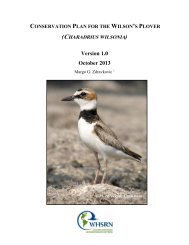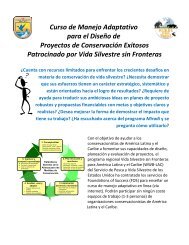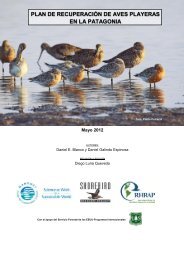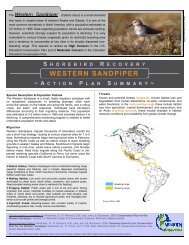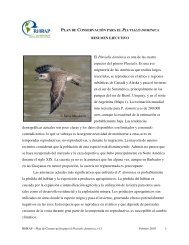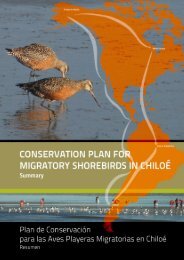Sanderling Plan - Western Hemisphere Shorebird Reserve Network
Sanderling Plan - Western Hemisphere Shorebird Reserve Network
Sanderling Plan - Western Hemisphere Shorebird Reserve Network
Create successful ePaper yourself
Turn your PDF publications into a flip-book with our unique Google optimized e-Paper software.
CONSERVATION THREATS<br />
<strong>Sanderling</strong>s face a number of conservation threats especially during the nonbreeding<br />
season. Because the <strong>Sanderling</strong> is a relatively long-lived species with low reproductive rates,<br />
even small changes in adult survival can have significant impacts on its population dynamics.<br />
Hence, it is imperative to understand and target those factors that may potentially affect (or<br />
already be affecting) adult survival.<br />
The most likely threats causing declines in <strong>Sanderling</strong> are:<br />
1) Habitat loss and degradation;<br />
2) Human disturbance;<br />
3) Contaminants and disease;<br />
4) Climate change<br />
5) Predation<br />
HABITAT LOSS AND DEGRADATION<br />
Coastal habitats (particularly sandy beaches), upon which <strong>Sanderling</strong>s rely for most of<br />
their lifecycle, are being heavily developed and fragmented by human activities. Since the early<br />
1900s, more than 50% of U.S. coastal wetlands have been lost, with much heavier losses in<br />
certain states, for example New Jersey, North Carolina, Florida (Helmers 1993) and most of<br />
California. Habitat impacts are occurring at two scales: specific and widespread. At the specific<br />
scale, habitat loss (e.g., from development) or habitat degradation (e.g., oil spills) at important<br />
staging areas could have potentially catastrophic impacts. However, no less damaging is the<br />
cumulative effect of widespread alterations occurring throughout the nonbreeding range from<br />
small-scale, piecemeal development or conversion of habitat (Morrison and Ross 1989). These<br />
widespread threats will increase as human population and pressures on coastlines increase.<br />
Hence, a prudent conservation strategy for <strong>Sanderling</strong>s must likewise target sites at two scales –<br />
sites that host large numbers of birds (i.e., especially in migration), and those that host moderate<br />
numbers throughout the nonbreeding range.<br />
Habitat loss has particularly significant implications for <strong>Sanderling</strong>s during migration—a<br />
time when they must put on fat to fuel their long flights—and also in winter (stressful weather).<br />
The potential cost during migration is clear: without enough fuel (fat), <strong>Sanderling</strong>s may not be<br />
WHSRN – <strong>Sanderling</strong> Conservation <strong>Plan</strong>, February 2010, v1.1 37





